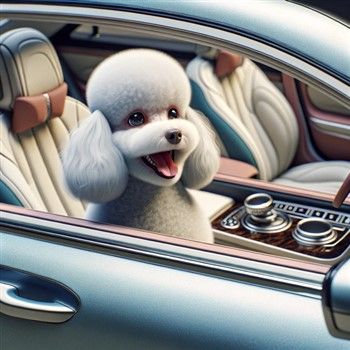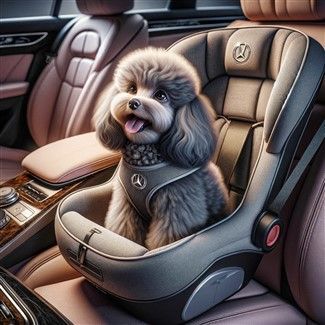Your Poodle in the Car -Car Seats & Motion Sickness Tips

Overview
- Top tips to prevent motion sickness
- Some eye-opening facts about driving with puppies and dogs in the car
- The best types of car seats and belts for all Poodles
- Extra tips for safety and comfort
Please note: AllPoodleInfo is reader-supported, and some of the product suggestions on this page are affiliate links. As an Amazon Associate we earn from qualifying purchases. This is at no extra cost to you and helps us keep this site running.
Note: If your Poodle does fine in the car without motion sickness, you may wish to jump down to: Can Car Rides be Dangerous for Poodles, which leads to Car Seats.
Poodle Motion Sickness
And if a Poodle panics quite a bit in the car, but their stomach seems to handle things, you may wish to try Bach Flower Essences Rescue Remedy, which is a homeopathic formula designed to provide calming relief. These are drops that you put in your Poodle's food or water about 30 minutes for a car ride.
Can Car Rides be Dangerous for Poodles?
The Best Types of Car Seats and Car Belt Restraints for Poodles

- Are raised. This keeps a small dog up high with good line-of-sight out of the windows and closer to fresh air, which greatly cuts down on motion sickness.
- Provides stability. This will be via walled structures, which can range from wired mesh to formed foam. It creates a structured area.
- Easy install. The car seat is easily secured into place with the car’s safety belt.
- Harness clip. The inner rear panel will have a harness buckle. Note that this is meant to clip to a puppy or dog’s harness, not a collar. Connecting this to the collar can result in severe neck injury. One that we like is the PetsFit Booster Seat; it's for dogs up to 25 lbs.
For dogs 25 to 45+ lbs. a canine seat safety harness seat belt is a good option:
With larger dogs, you’ll find that a harness/connector belt works very well. Note that there are 2 parts to this. The harness, which distributes pressure over the shoulders, chest and back (not the neck), and the connector strap which connects the harness to the car’s seat belt.
If your Poodle already has a great harness, you can opt just for the connector belt. Or, you can obtain the set of both the harness and the connecting strap. We really like the VavoPaw Dog Vehicle Safety Vest Harness; it's comfortable and easy to put on.
